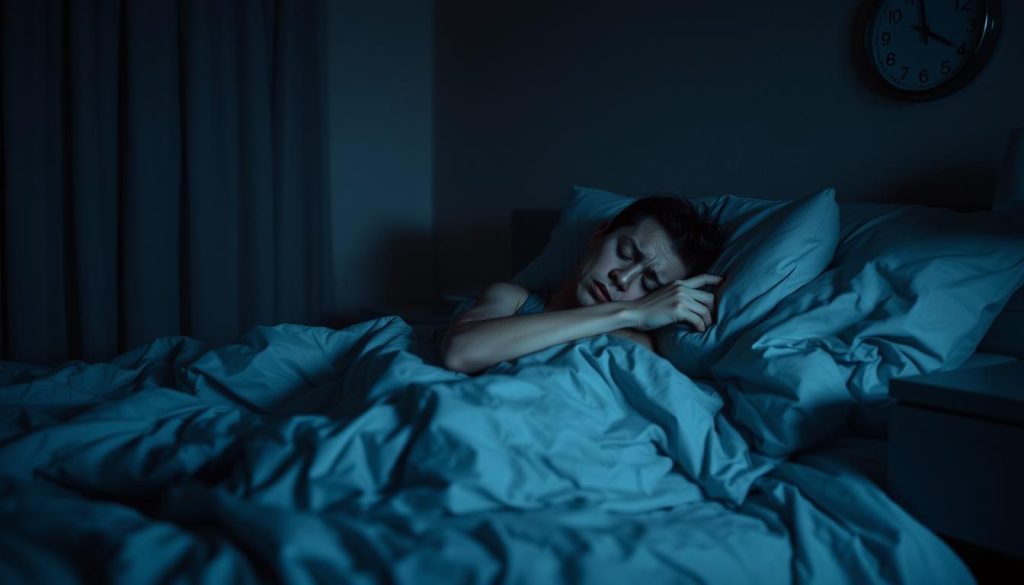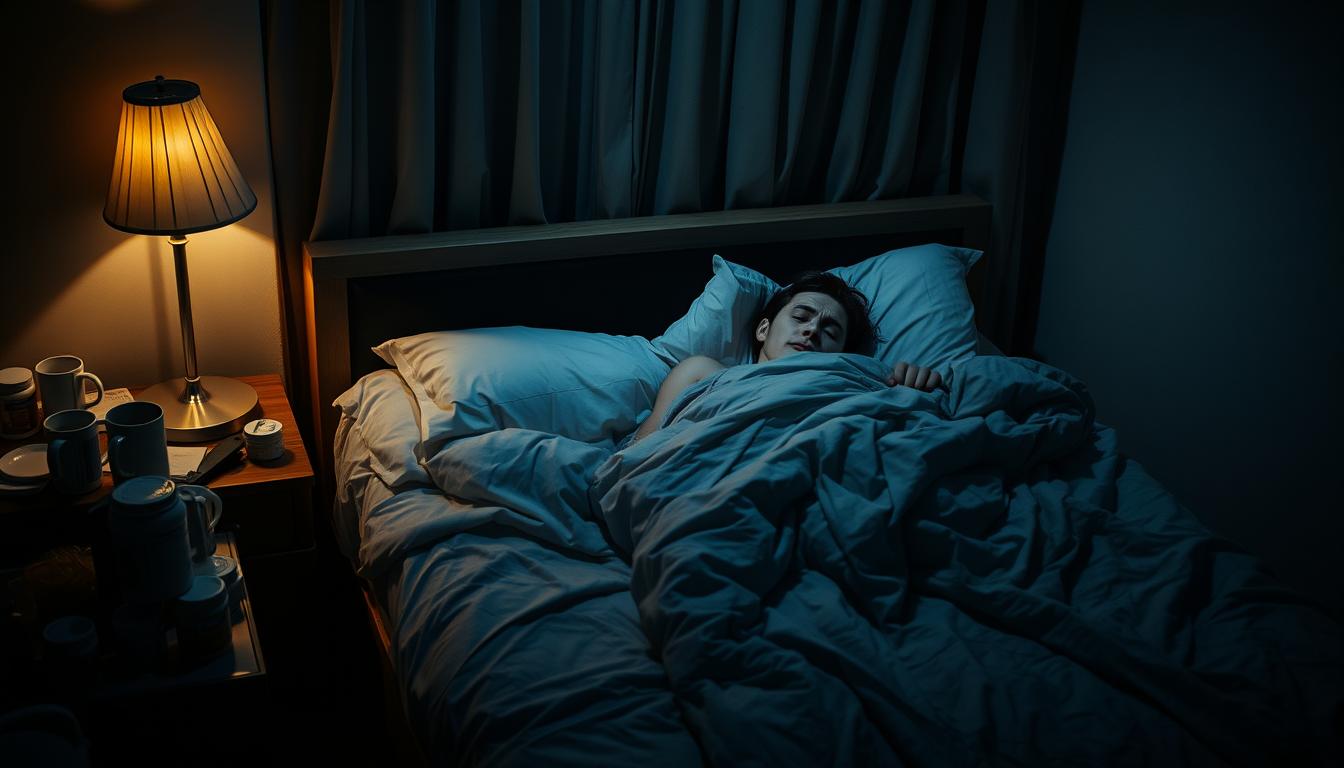Living with Delayed Sleep Phase Syndrome (DSPS) feels like a constant battle against your body’s rhythm. People with DSPS find it hard to fit into the day because their sleep cycle is off. This section will explore the complexities of DSPS and discuss ways to manage it.
We’ll look at strategies and treatments to help you live a more balanced life. Knowing the challenges of DSPS is the first step towards finding a better routine.
Understanding Delayed Sleep Phase Syndrome
Delayed Sleep Phase Syndrome (DSPS) is a disorder that messes with your sleep schedule. Knowing what DSPS is, why it happens, and its signs can help manage it better.
What is Delayed Sleep Phase Syndrome?
DSPS is a sleep disorder that makes it hard to sleep and wake up on time. It leads to not getting enough sleep. Unlike common insomnia, DSPS doesn’t make it hard to stay asleep once you’re asleep. But, it does make it tough to fall asleep when others do.
Causes of DSPS
DSPS can come from many things, like genes, environment, and lifestyle. Family history and too much screen time before bed can make it worse. A regular routine and avoiding blue light can help manage DSPS.
Symptoms of DSPS
Spotting DSPS symptoms early is key. Signs include trouble sleeping at the right time, waking up hard in the morning, and feeling very sleepy during the day. People with DSPS might feel awake and ready to go at night. Knowing these signs can help find the right treatment.
Impacts of DSPS on Daily Life
Delayed Sleep Phase Syndrome (DSPS) changes many parts of daily life. It affects physical health, social interactions, and work. Knowing these effects is key to better sleep and a better life.
Physical Health Effects
DSPS can cause big problems with sleep. This can lead to heart disease and obesity. It also messes with metabolism, raises stress, and hurts overall health.
Mental Health Effects
DSPS can really hurt mental health too. It can make anxiety and depression worse because of lack of sleep. So, managing insomnia is very important for mental health.
Social and Professional Challenges
Living with DSPS makes it hard to keep up with friends and work. Irregular sleep can cause missed social events and poor job performance. It leads to feelings of isolation and stress. Managing insomnia well is key to a balanced life.
Diagnosing Delayed Sleep Phase Syndrome
Getting a Delayed Sleep Phase Syndrome (DSPS) diagnosis starts with a sleep specialist consultation. This is key because it offers personalized advice and strategies for managing DSPS.
Consulting a Sleep Specialist
In your first meeting with a sleep specialist, they will look at your sleep patterns and medical history. They will also check for any other conditions that might be linked to DSPS. They help you explore sleep therapy options and guide you on the right path for a correct DSPS diagnosis.
Common Diagnostic Tests
Sleep specialists use tests like actigraphy and polysomnography to confirm DSPS. Actigraphy tracks your sleep-wake cycles with a wrist device over days or weeks. Polysomnography, done in a sleep lab, monitors brain waves, oxygen levels, heart rate, and muscle activity. It gives a detailed look at your sleep patterns.
Keeping a Sleep Diary
Keeping a sleep diary is a crucial step in diagnosing and managing DSPS. It should note your bedtime, wake time, sleep quality, and any nighttime disturbances. A detailed sleep diary helps in accurate diagnosis and tracks the success of sleep therapy, making treatment more effective.
Effective Sleep Hygiene Practices
Good sleep hygiene is key to managing insomnia and establishing healthy sleep habits. These habits are vital for those with Delayed Sleep Phase Syndrome (DSPS). Here are some tips to improve your sleep hygiene and get better rest at night.
- Establish a Regular Sleep Schedule
- Create a Bedtime Routine
- Design a Sleep-Conducive Environment
Being consistent with your sleep schedule is important. Going to bed and waking up at the same time every day helps your body’s internal clock. This not only helps with insomnia but also promotes healthy sleep habits.
A calming bedtime routine tells your body it’s time to sleep. Reading a book, doing relaxation exercises, or listening to soft music can help you relax and sleep better.
Your bedroom’s environment is crucial for good sleep. Make sure it’s dark, quiet, and cool. Use blackout curtains, white noise machines, or earplugs to make it perfect for sleeping.

Adding these practices to your daily life can greatly improve your sleep quality and overall health. Focus on sleep hygiene, regularity, and a calming pre-sleep routine. These are key to developing healthy sleep habits.
To sum up, here’s a comparison of effective sleep hygiene practices:
| Practice | Description | Benefits |
|---|---|---|
| Regular Sleep Schedule | Going to bed and waking up at the same time every day | Regulates body’s internal clock, aids in insomnia management |
| Bedtime Routine | Engaging in calming activities before bed | Promotes relaxation, eases transition to sleep |
| Sleep-Conducive Environment | Creating a dark, quiet, and cool bedroom | Improves sleep quality and duration |
Behavioral Therapy for DSPS
Delayed Sleep Phase Syndrome (DSPS) can be tough to handle. But, behavioral therapies offer hope. They help reset your body’s clock and improve sleep quality.
Cognitive Behavioral Therapy for Insomnia (CBT-I)
Cognitive behavioral therapy is key in managing sleep issues. CBT-I changes thoughts and behaviors that lead to insomnia. It helps patients form better sleep habits and tackles DSPS by addressing sleep barriers.
Light Therapy
Light therapy is a big help for DSPS. Bright light at certain times can align your body’s clock. A lightbox mimics sunlight, making it easier to adjust your sleep schedule.
Melatonin Supplementation
Melatonin for DSPS can be a big change. This hormone controls the sleep-wake cycle. Taking melatonin at the right time signals sleep readiness. Always use it with a healthcare provider’s advice for the best results.
Medication and Medical Treatments
Dealing with Delayed Sleep Phase Syndrome (DSPS) needs a mix of treatments. Using both prescription drugs and alternative sleep therapies can really help. These methods can improve sleep and health a lot.
Prescription Medications
Doctors often use melatonin receptor agonists and sedative-hypnotics to adjust the body’s clock. Melatonin supplements are a top choice to help the sleep-wake cycle. They might also prescribe drugs like ramelteon (Rozerem) or eszopiclone (Lunesta) to help sleep at the right time.
Alternative Therapies
There are non-drug ways to fight DSPS. Acupuncture and meditation try to get the body’s rhythms in sync and lower stress. Cognitive-behavioral therapy works on changing behaviors and thoughts that mess with sleep. These methods can work well with medicine, offering a complete health plan.

Professional Sleep Therapy
Getting help from sleep specialists is key. They do detailed checks and make plans just for you. These plans might include light therapy and special tests. They teach about sleep hygiene and how to set a good sleep schedule. This way, people with DSPS get care that really works for them.
Managing DSPS in Teens
Teenagers with Delayed Sleep Phase Syndrome (DSPS) face special challenges. Their sleep patterns often shift, causing late nights and morning struggles. To manage DSPS in teens, we need a plan that includes school, social life, and parental support.
Adolescent Sleep Patterns
Adolescents naturally sleep later due to changes in their body clocks. It’s key for parents and teachers to understand these changes. Teens with DSPS find it hard to sleep and wake up on time, so we must meet their unique needs.
School and Social Life Adjustments
DSPS affects teens’ school work and social life. Changing school start times can help match their sleep patterns. Also, finding social activities that don’t disrupt their sleep is important for a balanced life.
Parental Support and Guidance
Parental guidance for DSPS is vital for teens. Talking openly about sleep issues and setting a regular sleep routine helps a lot. Parents can also push for school changes to support their child. A supportive home environment that understands and helps can greatly improve a teen’s life with DSPS.
Living with DSPS: Personal Stories
Delayed Sleep Phase Syndrome (DSPS) can really affect daily life. Hearing from others can help those looking for understanding and tips. We share real-life DSPS stories to see how people have dealt with their sleep issues.
Real-life Experiences
People with DSPS face special challenges. Sarah, a college student, had trouble sleeping before 3 AM. She missed morning classes, hurting her grades. Finding out she had DSPS helped her manage her sleep better.
Overcoming Challenges
Beating DSPS sleep problems needs a few steps. Sarah started strict bedtime routines and avoided blue light before bed. Her story shows how important it is to know about DSPS and find ways to deal with it.
Success Strategies
Managing DSPS well can make life better. Sarah used light therapy and melatonin to adjust her sleep. These strategies helped her sleep more like everyone else, showing it’s possible to improve with DSPS.

Creating a Supportive Sleep Environment
Creating a calm and sleep-friendly space is key for those with Delayed Sleep Phase Syndrome (DSPS). It’s important to reduce light and noise in the bedroom. Heavy curtains or blinds help block out unwanted light that can disrupt sleep.
The right bedding is also crucial. It should be comfy and keep your body at the right temperature for sleep. High-quality cotton sheets and supportive pillows can greatly improve your sleep.
Keeping your room at the right temperature is also vital. The ideal bedroom temperature for sleep is between 60 and 67 degrees Fahrenheit. You can use fans or adjust your thermostat to get it just right.
To sum up, here are the key steps to create a sleep-friendly environment:
| Strategy | Description |
|---|---|
| Minimize Light Pollution | Use blackout curtains and eliminate electronic light sources before bedtime. |
| Reduce Noise Pollution | Employ white noise machines or earplugs to block disruptive sounds. |
| Choose Optimal Bedding | Invest in high-quality sheets and pillows for maximum comfort. |
| Maintain Room Temperature | Keep your bedroom between 60-67°F for optimal sleep conditions. |
The Future of DSPS Treatment
The future of sleep therapy for Delayed Sleep Phase Syndrome (DSPS) is looking bright. Researchers and medical experts are working hard to find new treatments. They are focusing on chronotherapy and light therapy to help reset the body’s clock.
They are also working on new medicines to help with sleep. These medicines aim to improve sleep without causing bad side effects. Gene therapy might also become a big help, targeting the genetic causes of DSPS.
Technology is also playing a big role in finding new solutions. Wearable devices and sleep tracking tools are being developed. They will help monitor and manage DSPS, offering real-time advice and personalized plans. This mix of research and technology brings hope for better treatments for DSPS.

